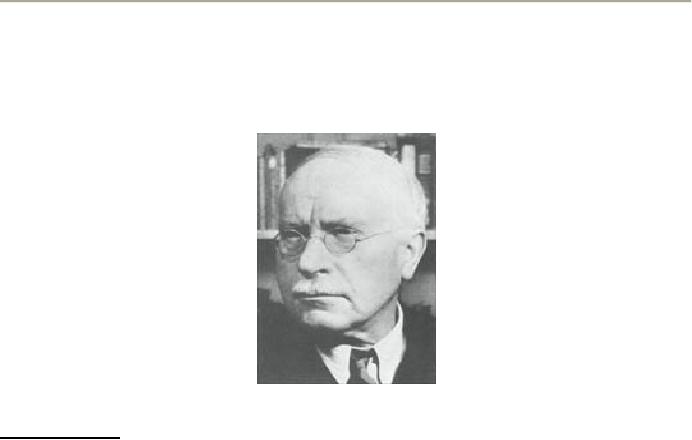 |
JUNG’S ANALYTICAL PSYCHOLOGY:Carl Gustav Jung |
| << CARL JUNG AND ANALYTICAL PSYCHOLOGY:Carl Gustav Jung |
| ALFRED ADLER AND INDIVIDUAL PSYCHOLOGY:Alfred Adler >> |

History
and Systems of Psychology
PSY502
VU
Lesson
32
JUNG'S
ANALYTICAL PSYCHOLOGY
Carl
Gustav Jung (1870-1961)
Carl
Gustav Jung
Carl
Gustav Jung developed an elaborate theory
of dreams and dream
interpretation. Jung proposed
that
the
average dream is similar in
structure to a drama; Jung maintained
that however some dreams could
be
too
short or fragmented to fit into this
structure. Unlike Freud,
Jung believed that the manifest
dream (the
dream
as remembered) contains the actual
meaning of the dream the dream is
therefore not distorted or
disguised
in any way. It is a message or natural
expression of the unconscious. Therefore,
interpretation
should
be based upon a series of
dreams rather than a single
dream. The usual practice
was to interpret each
dream
separately, irrespective of what was in
the following dream. In Jung's
view, dreams show
wishes,
desires,
conflicts and even give warning about
future. He said that a dream
is difficult to interpret
and
understand
since it is expressed in its
own unique language of symbols. In
order to interpret a dream,
Jung
used
the process of amplification. In
essence, amplification involves
elaborating a dream image in order
to
determine
its significance through direct
and indirect association.
This is achieved by gaining an insight
into
the
dreamer's personal associations
with the image (direct association), in
order to discover the
feelings
evoked
by a particular dream image or symbol.
The meaning and significance
of a particular word or image
can
vary greatly between individuals
depending on the effect it has had on
his/her life. The
cultural
significance
of the image, as well as drawing
parallels from the symbolism contained in
folklore, history,
fairytales,
religion, mythology, rituals
etc.
As
mentioned earlier, Jung believed that a
series of dreams is much
easier to interpret than a
single dream.
This
is due to the fact that significant
images will be repeated and
the basic ideas and themes
behind the
dreams
can be recognized more
easily. A series of dreams
usually indicates a complex conflict.
Jungian
dream
interpretation also places a
great deal of importance on the conscious
situation of the dreamer. The
dream
is not an isolated event and cannot be
detached from the dreamer's
everyday life.
Jung
developed a system of psycho-therapy
based upon his theory of
analytical psychology. According
to
Jung
psychotherapy is not healing
but helping to develop. He rejected
free association and
adopted
dialogue,
discussion and full
confession.
72
History
and Systems of Psychology
PSY502
VU
The
steps involved in Jungian therapy
are:
�
Reading
(for some)
�
Collaboration
with the therapist
�
Focusing
on the situation at present
�
Making
any insight concrete and
finding a way to put it into
practice.
He
also used interpretations of dreams in
his method. He further took
into view the positive side
neurosis.
Jung
also stressed the importance of religion
in life. He stated that to
cure is to make a person
symptom
free,
but the aim of psychotherapy is
individuation.
73
Table of Contents:
- INTRODUCTION:Methodology, Grading, Course Overview up to Midterm
- ANCIENT GREEK PHILOSOPHY/PSYCHOLOGY:Socrates, Plato
- GREEK THINKERS:Aristotle, Contiguity, Contrast
- PSYCHOLOGY IN THE 5TH TO 12TH CENTURY:Saint Augustine, Avicenna
- PSYCHOLOGY IN THE 5TH TO 12TH CENTURY:Al-Ghazali, Ibn-Rushd, Averroes
- RENAISSANCE:Rene Descartes
- ASSOCIATIONISTS:Thomas Hobbes, John Locke
- ASSOCIATIONISTS:David Hume, FRENCH REVOLUTION, Denis Diderot
- GERMAN CONTRIBUTION:Wilhelm Liebniz, Immanuel Kant, Friedrich Hegel
- INDUSTRIAL REVOLUTION:RUSSIAN CONTRIBUTIONS
- RUSSIAN CONTRIBUTIONS:Ivan Pavlov, Reflex, Acquisition
- RUSSIAN CONTRIBUTIONS:Vladimir Bekhterev
- IMPACT OF PHYSICAL SCIENCES ON PSYCHOLOGY:Charles Darwin, Gustav Fechner
- STRUCTURALIST SCHOOL OF PSYCHOLOGY:Wilhelm Wundt
- FUNCTIONALISM:William James, John Dewey
- EUROPEAN FUNCTIONALISTS:David Katz, Edgar Rubin, Jean Piaget
- BEHAVIORISM:Edward Lee Thorndike, Law of belongingness
- BEHAVIORISM:Albert Weiss, Edwin Holt, Learning, Canalization, Walter Hunter
- BEHAVIORISM:J.B.Watson
- NEO-BEHAVIOURISTS:Clark Hull, Edward Tolman, Edwin Gutherie
- NEO-BEHAVIORISTS:B.F. Skinner, Karl Lashley, Donald Hebb, Hobart Mowrer
- GESTALT PSYCHOLOGY:Max Wertheimer, Similarity, Proximity, Closure
- GESTALT PSYCHOLOGY:Wolfgang Kohler, Kurt Koffka, Edward De Bono
- GESTALT SCHOOL AND DYNAMIC PSYCHOLOGY:Kurt Lewin, DYNAMIC PSYCHOLOGY
- HISTORICO-EVOLUTIONARY PSYCHOLOGY:Leon Vygotsky, Sergei Rubenstein
- HISTORICO-EVOLUTIONARY PSYCHOLOGY:Alexei Leontiev, K.M Bykov
- SCIENTIFIC LOOK AT MENTAL DISORDERS
- SCIENTIFIC LOOK AT MENTAL ILLNESS:Philippe Pinel, Sameul Tuke
- SIGMUND FREUD AND THE PSYCHOANALYTIC MOVEMENT:The Superego
- SIGMUND FREUD AND PSYCHOANALYTICAL MOVEMENT:Anna Freud
- CARL JUNG AND ANALYTICAL PSYCHOLOGY:Carl Gustav Jung
- JUNG’S ANALYTICAL PSYCHOLOGY:Carl Gustav Jung
- ALFRED ADLER AND INDIVIDUAL PSYCHOLOGY:Alfred Adler
- NEO-FREUDIANS:Harry Stack Sullivan, Karen Horney
- NEO-FREUDIANS:Karen Horney, Erich Fromm
- ERIKSON and MORENO:J.L. Moreno, Protagonist, Audience, Role playing
- HUMANISTIC PSYCHOLOGY:Abraham Maslow, Carl Rogers, Positive Psychology
- MODERN TRENDS IN PSYCHOLOGICAL TREATMENT
- MODERN TRENDS IN PSYCHOLOGICAL TREATMENT:Biological Approaches
- ANTI-PSYCHIATRY MOVEMENT:D.L. Rosenhan, R.D. Laing, Aaron Esterson
- PSYCHOLOGY IN THE THIRD WORLD:Frantz Fanon
- PSYCHOLOGY IN THE THIRD WORLD CHINA AND PAKISTAN
- PSYCHOLOGY IN THE 21st CENTURY
- PSYCHOLOGY IN THE 21ST CENTURY:Consumer Psychology
- PSYCHOLOGY IN THE 21ST CENTURY:Sports Psychology, Positive Psychology